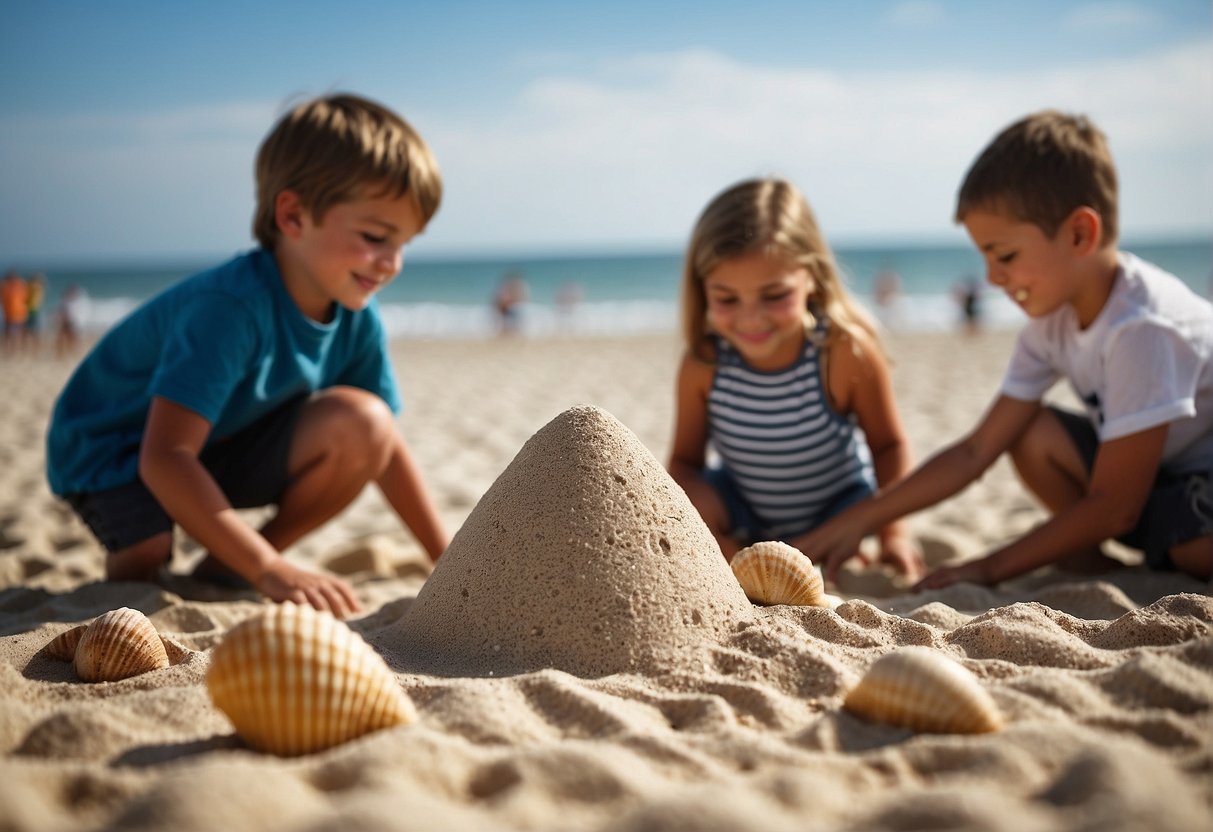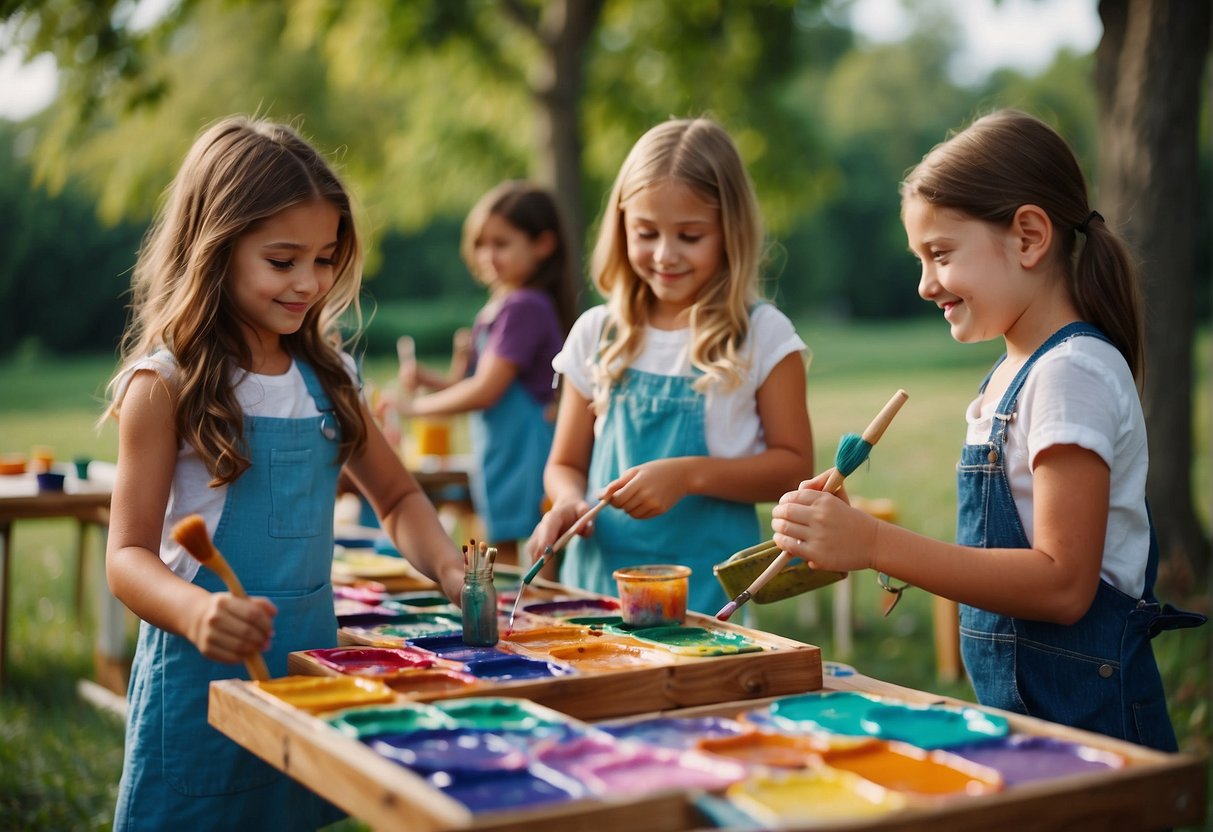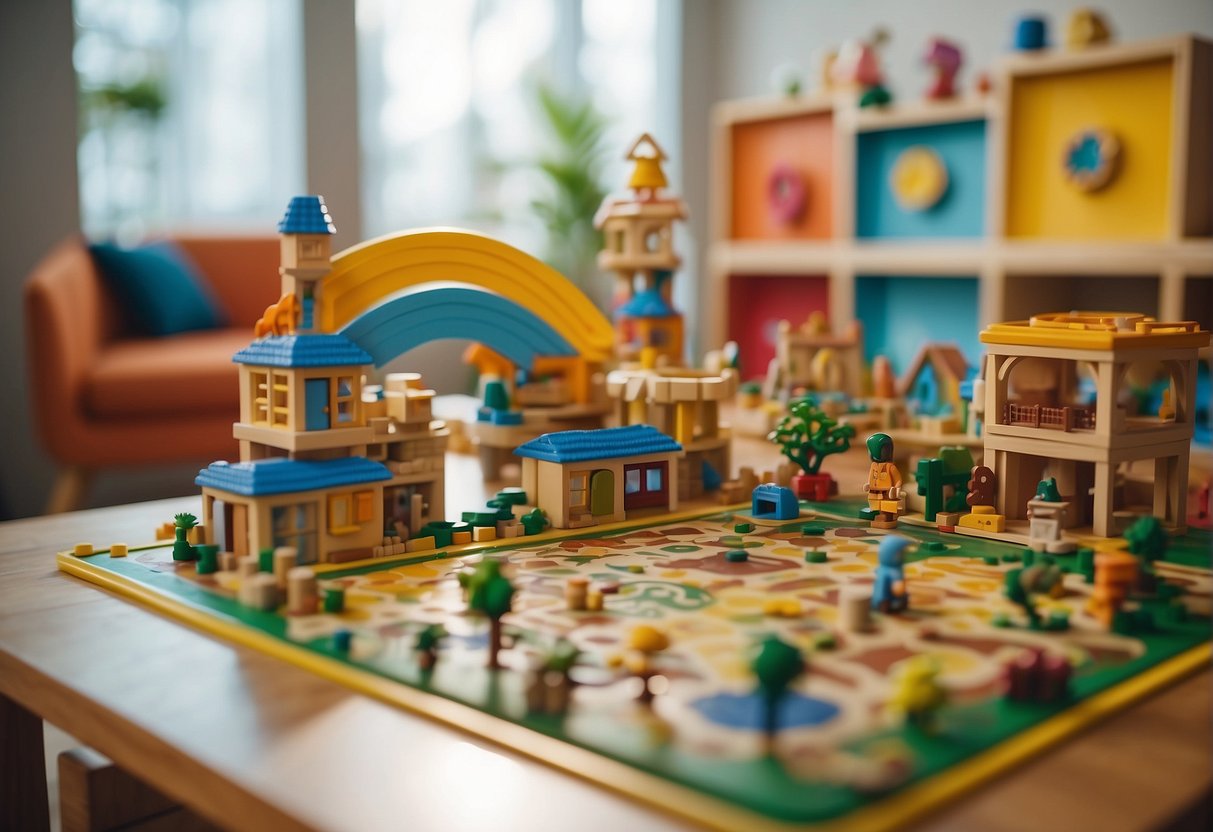Sand play offers children an incredible avenue to explore their creativity and engage in sensory play. It is a tactile and versatile medium that encourages the development of fine motor skills through the manipulation of sand to form various shapes and structures. Beyond the joy of building castles, children can benefit from the therapeutic qualities of sand play, finding calmness and focus as they pour, sift, and sculpt.

Innovative sand play activities extend far beyond the traditional sandbox, encompassing a variety of educational and developmental experiences. Children can explore different textures by mixing dry and wet sand, learn about the concepts of volume and measurement, and even delve into role-playing as they become mini archaeologists uncovering hidden treasures or palaeontologists discovering ancient relics.
Sensory bins filled with sand can serve as miniature landscapes for imaginative play, allowing kids to create their own worlds populated by toy figures and natural elements. These contained play spaces not only contain the potential mess but also provide a focused environment where children can immerse themselves in open-ended play. Through the simplicity and flexibility of sand, the possibilities for play are vast, offering joy and learning opportunities to children of various ages and interests.
Fundamentals of Sand Play

Sand play is an interactive form of play that stimulates children’s senses, particularly the sense of touch. It often occurs in a sensory bin—a container filled with sand that enables a contained sensory experience. Through various sand activities, such as digging or building, children can develop fine motor skills and hand-eye coordination, which are essential for their overall sensory development.
Sensory Activities: These activities involve the manipulation of sand, be it scooping, sifting, or shaping, allowing children to explore different textures and consistencies. Such interactions promote tactile learning and sensory experiences, contributing to a child’s discovery and understanding of the world around them.
Learning through Play: As children engage with sand, they are not only playing but also learning. The experience helps them to gain control over their fine motor skills while fostering creativity and cognitive growth. Manipulating the sand with various tools or even their own hands enhances hand-eye coordination.
-
Key Component 1: Fine motor skills development
- Scooping
- Pouring
- Picking up small objects
-
Key Component 2: Sensory experience enhancement
- Feeling different textures: wet, dry, coarse, fine
- Experiencing temperature and weight differences
-
Key Component 3: Learning and growth encouragement
- Creative expression through shaping and building
- Cooperative play with others, improving social skills
In summary, the fundamentals of sand play sit at the intersection of tactile engagement and developmental learning. These sensory-rich activities are indispensable in promoting a child’s sensory development while they learn through the joyful act of play.
Creating with Sand

Sand provides a versatile medium for children and adults alike to engage in creative activities. These activities can range from traditional building to the more intricate craft techniques, and even the science of mixing components to create new textures such as sand foam and slime.
Building and Sculpting
When it comes to sand play, building and sculpting stand out as fundamental activities. They are as simple as molding sandcastles to architecting entire cities with moats and towers. To facilitate building, damp sand works best as it can hold shapes more effectively. Children can utilize simple tools like buckets, shovels, and even recycled containers to shape their sandy creations. They not only foster creativity but also enhance fine motor skills and spatial awareness.
Sand Art and Craft Techniques
Sand art and craft techniques encompass a wide range of activities beyond shaping and building. One popular method involves creating sand collage artworks. This is done by forming patterns with liquid glue on paper or cardboard and sprinkling coloured sand on top. Additionally, mixing sand with paint introduces a textured aspect to painting, inviting children to explore sensory experiences while expressing artistic intent.
Making Sand Foam and Slime
Sand foam and sand slime represent a sensory adventure, perfect for hands-on experimentation. Making sand foam generally requires combining shaving cream with sand to create a fluffy and moldable mixture. Sand slime, on the other hand, merges the concepts of playdough and slime to produce a stretchy, yet sculptable material. These concoctions support learning through play, allowing children to understand properties such as volume, consistency, and the science of materials.
Interactive Sand Play Ideas

Interactive sand play engages children’s senses and ignites their imagination through tactile experiences. Here are specific activities to enrich their playtime.
Sensory Bins and Tables
Sensory bins and tables provide a focused environment for children to explore the textures and properties of sand. Kinetic sand and moon sand are excellent materials for these setups due to their moldable and soft qualities. They can sift, pour, and shape the sand, effectively enhancing their fine motor skills and sensory perception.
- Kinetic Sand Shapes: Have children use cookie cutters to create shapes in kinetic sand.
- Moon Sand Creations: Encourage children to mix moon sand with water to build detailed castles and sculptures.
Imaginative Play Scenarios
Imaginative play scenarios help in the development of storytelling and role-playing skills. A sand table becomes a stage for children to enact various narratives using figurines and crafted landscapes.
- Treasure Hunt: Bury small treasures in the sand and provide clues for a hunt.
- Dinosaur World: Create a prehistoric scene with dinosaur figurines and tracks in the sand.
Physical Activities and Challenges
This subsection focuses on activities that combine the tactile nature of sand with physical play. Digging and constructing sand volcanoes are just a few engaging ways to incorporate physical exertion and scientific exploration.
- Sand Volcano Building: Guide children to build a volcano out of sand and simulate an eruption with baking soda and vinegar.
- Tracks in the Sand: Encourage children to use toy cars or animals to create intricate tracks in the sand, challenging their spatial awareness.
Incorporating Natural Elements

Introducing natural elements like shells and stones into sand play enriches the sensory experience and fosters creativity. These items not only add tactile variety but can also serve as tools or decorations for imaginative play.
Using Shells and Stones
Shells and stones provide a multitude of options for sand play. Children can embed shells into the sand to create patterns or use them as focal points in their sandy designs. Shells with different textures and colors stimulate the senses and can double as “treasure” for hunting games.
Stones and pebbles also offer opportunities for learning and play. They can be sorted by size or color, and used to create intricate mosaics or pathways within sand structures. By incorporating these natural materials, children develop fine motor skills as they grasp, position, and embed each piece into the sand.
Beach and Ocean Themed Play
A beach or ocean-themed sensory bin is an excellent way for children to explore sand play with a nautical twist. To create an ocean sensory bin, one can add blue food coloring to water and place it alongside a sand area, emulating the shore and sea. Kids can then populate this mini-beach scenario with sea shells, small toy sea creatures, and even rocks and pebbles to serve as islands or underwater terrain.
Natural materials like sand, water, and shells encourage children to engage in imaginative play that imitates real-life beaches. Through this themed play, they gain a better understanding of different environments and the elements that comprise them, while refining their sensory perception and narrative skills.
Sand Play in Different Environments

Sand play can be adapted to various settings, offering children a diverse range of sensory and creative experiences. Whether indoors or outdoors, sand offers unique opportunities for play and learning across different environments.
Indoor Sandpit Adventures
In an indoor setting, the controlled environment of a sandpit allows for imaginative activities without concern for weather conditions. Here, children can engage in:
-
Sensory Bins: Replicating an ocean theme with a simple sensory bin can captivate a child’s interest. Shells, plastic sea creatures, and blue food coloring to represent water can enhance the sensory play.
-
Colorful Sand Art: Creating sand art with colored sand in a sandpit stimulates fine motor skills and artistic expression. It offers a mess-free option for indoor play, especially during colder months.
Garden and Outdoor Exploration
Outdoor sand play in a garden or playground brings children closer to nature and offers additional benefits during the summer months. Activities they might enjoy include:
-
Water Play: Adding water to a garden sandpit allows for experimentation with textures. Building moats and watching how sand changes when wet is both fun and educational.
-
Dinosaur Bone Hunt: Burying toy dinosaurs in a sandpit for children to discover simulates a fun paleontology dig, fostering problem-solving and an interest in history and science.
Educational Aspects of Sand Play

Sand play is a dynamic tool in early childhood education that fosters various developmental skills. It offers rich opportunities to enhance language, cognitive growth, and social interactions through imaginative play.
Development of Social Skills
Playing with sand naturally encourages children to work together, share tools like shovels and buckets, and negotiate roles and rules in their play scenarios. This cooperative play helps to build the foundation of social skills. They learn the art of compromise and the joy of shared accomplishments as they build sand structures in groups. The open-ended nature of sand play means every child can contribute, regardless of skill level, which promotes inclusivity.
Enhancing Language and Cognitive Growth
Sand play stimulates conversation and vocabulary development as children describe their actions and creations. Imagination thrives as they fabricate stories and assign roles, practicing narrative skills. Cognitive growth is evident as children experiment with concepts of physics like volume and gravity, and engage in problem-solving to construct their visions in the sandbox. It also provokes questions and exploration, which are key to cognitive development.
DIY Sand Play Materials

Creating personalized sand play materials at home can be both cost-effective and a fun craft. Focus on making non-toxic, child-friendly substances that can inspire creative play.
Creating Coloured and Textured Sand
To create coloured sand, one can mix sand with powdered tempera paint or food coloring. Start with placing sand into a sealable bag, add the coloring, and then shake the bag until the sand is evenly coated. For a more vibrant hue, add more coloring. Let the sand dry before use to prevent color transfer.
Textured sand can be made by mixing various grains and textures of sand together. One might combine fine sand with coarser grains or integrate small pebbles to create a tactile experience. Adding kid-friendly glitter or crushed seashells can enhance the sensory play.
Homemade Playdough and Kinetic Sand
DIY playdough can be prepared using common kitchen ingredients. A basic recipe includes flour, salt, cream of tartar, warm water, vegetable oil, and food coloring. Combine and cook the mixture until it forms a dough-like consistency. Once cooled, knead it well and store in an airtight container.
For DIY kinetic sand, mix regular sand with cornstarch, dish soap, and some water to achieve the desirable “mold-able” property. People often add food coloring or glitter for an interesting twist. Kinetic sand is known for its unique texture that sticks to itself but not to hands, making for an engaging sensory experience. Here’s a quick table guide to the ratios for homemade kinetic sand:
| Ingredient | Quantity |
|---|---|
| Fine sand | 6 cups |
| Cornstarch | 1.5 cups |
| Dish soap | 1 tbsp |
| Water (or as needed) | 1/2 cup (approx.) |
| Food coloring or glitter (optional) | Adjust to preference |
For both playdough and kinetic sand, one should ensure that all materials are safe and non-toxic, especially since young children will be handling them frequently.
Accessorizing Sand Play

Enhancing sand play can be accomplished through the creative use of various accessories that promote imagination and fine motor development. By incorporating loose parts and various tools, children can develop their creativity and engineering skills while having fun in the sand.
Loose Parts and Imaginative Add-ons
Loose parts, such as small toys, can transform a simple sandbox into an imaginative playground. Children may integrate plastic figurines, like dinosaurs, to enact prehistoric scenes where they unfold narratives of discovery and adventure. Adding items such as shells, pebbles, or even plastic bottles can encourage children to explore texture and form, perhaps utilizing the bottles to create impromptu water features or as molds for sand structures.
- Examples of loose parts:
- Small toys (dinosaur figurines, cars)
- Natural materials (shells, rocks)
- Recyclables (plastic bottles, caps)
Tools for Shaping and Building
Tools are essential for shaping and constructing more intricate sand creations. Sand toys specifically designed for building, like shovels, rakes, and molds, help children in crafting detailed sand castles and structures. Simple kitchen utensils, such as sieves, spoons, and measuring cups, can be repurposed as sand sculpting tools allowing for a variety of textures and shapes.
- Essential building tools:
- Shovels and rakes for excavation and pattern-making
- Molds for forming precise shapes
- Creative repurposed items (colanders, spoons)
By introducing thoughtful accessories to sand play, children can deepen their play experience, fostering learning through hands-on interaction.
Safety and Maintenance

When engaging in sand play activities, safety is a priority. Parents and educators should ensure that the sand area is free from hazardous materials. They should regularly inspect the sand for debris or sharp objects that could harm children. Additionally, the use of non-toxic, child-safe sand is recommended to prevent ingestion of harmful substances.
Maintenance of sand play areas is essential to preserve the cleanliness and functionality of the space. Here’s a brief guide to maintaining a sand play area:
- Daily Maintenance: At the end of each play session, toys and tools should be collected and stored to prevent loss or damage. Any litter should be removed from the sand.
- Weekly Maintenance: Rake the sand to aerate it and to keep the surface level and free of clumps. This is also the time to check for and remove any foreign materials.
- Monthly Maintenance: Wet the sand slightly to keep it fresh, as completely dry sand can become dusty. Evaluate if the sand needs replenishing or if the entire sand should be replaced to maintain a hygienic play area.
Safety and maintenance in sand play activities should include:
- Supervision: Children should always be under adult supervision to ensure they are playing safely.
- Sanitation: Hands should be washed before and after playing in the sand to prevent the spread of germs.
Enforcing these safety and maintenance routines will ensure that sand play activities remain enjoyable and beneficial for children’s development.
Advanced Sand Play Techniques

When elevating sand play, incorporating techniques that challenge creativity and fine motor skills enriches the experience. These advances move beyond basic castle construction to more intricate activities like baking imaginary food out of sand and merging art with education to enhance the overall playtime.
Sand Baking and Cooking Imaginary Food
Children can expand their playtime repertoire by engaging in sand baking and cooking imaginary food. By supplying a variety of molds and kitchen tools, they can create sand mud pies and other delicacies, refining their ability to measure, scoop, and decorate. Encouraging pretend play in this way fosters cognitive development while they engage in the mimicry of real-world cooking techniques.
- Ingredients and utensils:
- Molds (for cakes, cookies)
- Shovels (in place of spoons or mixers)
- Buckets (as mixing bowls)
- Leaves and sticks (for decoration)
Children’s culinary sand creations might range from simple pies to complex feasts, depending on their level of skill and imagination.
Incorporating Art and Learning Activities
Integrating art and learning into sand play offers a multi-sensory educational experience. Sand can be used as a canvas for sand painting, where children sprinkle colored sand to create vibrant pictures. This activity not only allows for artistic expression but also enhances hand-eye coordination.
- Art and learning tools:
- Colored sand
- Brushes or sticks (for drawing and painting)
- Stencils (to create shapes and patterns)
Additionally, children may engage in a writing practice activity by using their fingers or sticks to draw letters and words in the sand, turning playtime into a reading readiness exercise. This tactile approach to learning captures the foundational steps of writing while maintaining an element of fun.
Seasonal Sand Play Themes

Summer
With the warmth of summer, sand play offers endless outdoor fun for children. They can embrace classic activities like building sandcastles or get creative with seasonal twists.
Ocean Sensory Bin: Create a mini beach experience with a sensory bin filled with sand and water. Children can add seashells, ocean creature toys, and even algae for a touch of realism. Small buckets and shovels enhance the fun as they build their tiny shores.
Sandcastle Playdough Kits: These are perfect for both beach trips and backyard play. Moldable and easy to shape, they help children craft intricate castles complete with towers and gates. For a unique summer challenge, consider timing contests to see who builds the highest tower before the “tide” comes.
- Dinosaur Bone Excavation: Turn sandbox into an archaeological dig site. Bury toy dinosaur bones and provide children with brushes to gently uncover these prehistoric treasures.
- Beach Hopscotch: Drawing hopscotch grids in the sand adds a beachy twist to a familiar game. It encourages movement and balance as they toss pebbles and hop through the course drawn with sticks or fingers.
Toys to consider for enhanced play:
| Age group | Suggested Toys |
|---|---|
| Toddlers | Sand molds, small pails |
| Preschool | Miniature digging tools |
| School-age | Watering cans, sieves |
Notably, summer sand play supports social skills and physical coordination, while also sparking creativity in children as they sculpt and explore within the grains.
Adapting Sand Play for Various Ages

Sand play is an engaging and dynamic way to support a child’s development, suitable for all age groups. It can be especially beneficial for honing fine motor skills and hand-eye coordination. Here’s how to tailor sand play activities to different age groups:
Toddlers (1-3 years):
- Discovery in Sand: Allow toddlers to feel and explore the texture of sand through simple scooping, pouring, and sifting activities. Tools like cups, sieves, and small shovels can help.
- Simple Molds: Introduce basic sand molds to help toddlers begin to understand form and function.
Preschoolers (3-5 years):
- Creative Shapes and Structures: Encourage the use of sand molds for creating more intricate shapes as well as freeform structures.
- Interactive Play: Implement games that involve filling and emptying containers to promote hand-eye coordination.
School-Age Children (6+ years):
- Detailed Construction: Challenge older children with building complex sandcastles and sculptures, which requires patience and precision.
- Pattern Making: Using sticks or rakes to create patterns can further refine their fine motor skills and hand-eye coordination.
Each activity is designed to be age-appropriate, fostering growth in key developmental areas. As children grow, the complexity of the tasks can increase to match their advancing skills. Always ensure that the sand is clean and safe for play, and never leave children unattended during sand play.
- 15 Football-Themed Snack Ideas for Kids & Teens - September 9, 2024
- 15 Mistake Quotes For Kids - September 7, 2024
- Fun Shark Quotes and Sayings For Kids - September 7, 2024








